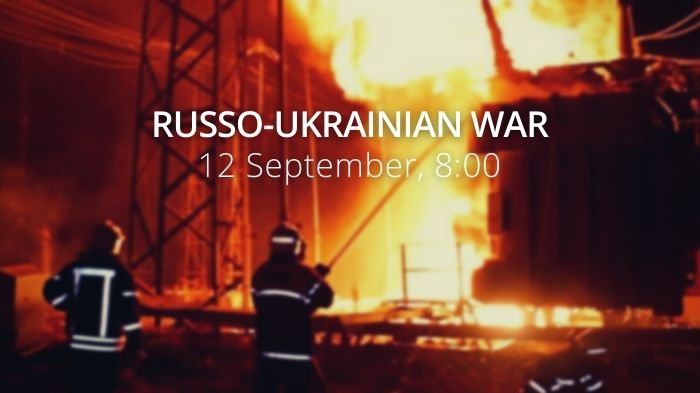Zelenskyy calls on Red Cross to help rescue people from flooded towns. Destruction of Kakhovka Dam continues, and reservoir water levels keep declining – Ukrhydroenergo. Ukraine approves missile program targeting 1,000+ km range – Defense Minister.
Daily overview — Summary report, June 9
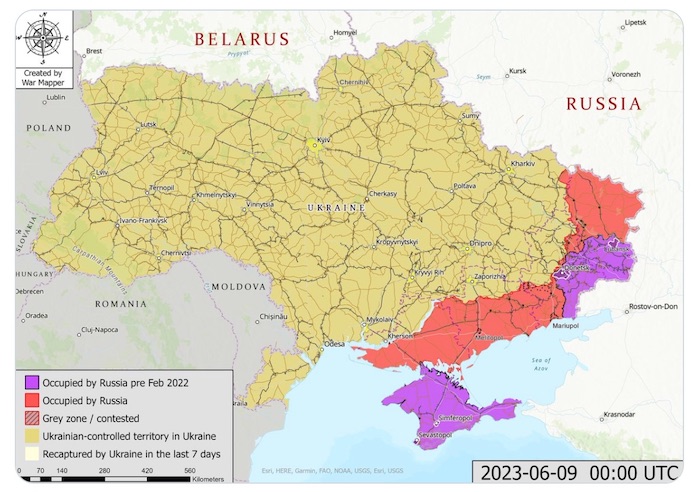
The General Staff’s operational update regarding the Russian invasion as of 18.00 pm, June 9, 2023 is in the dropdown menu below:



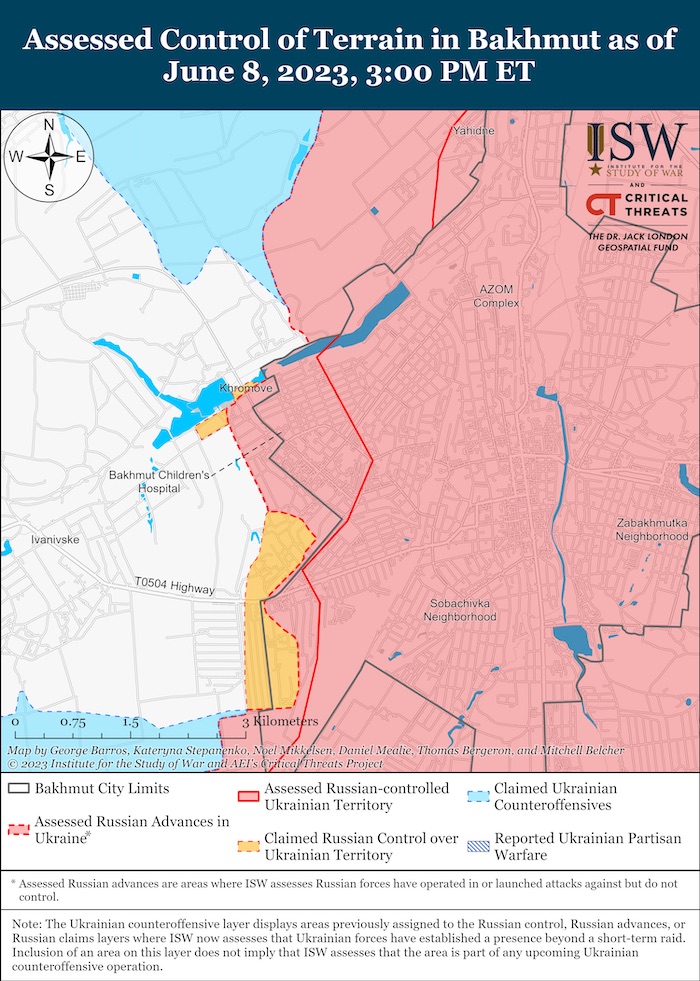
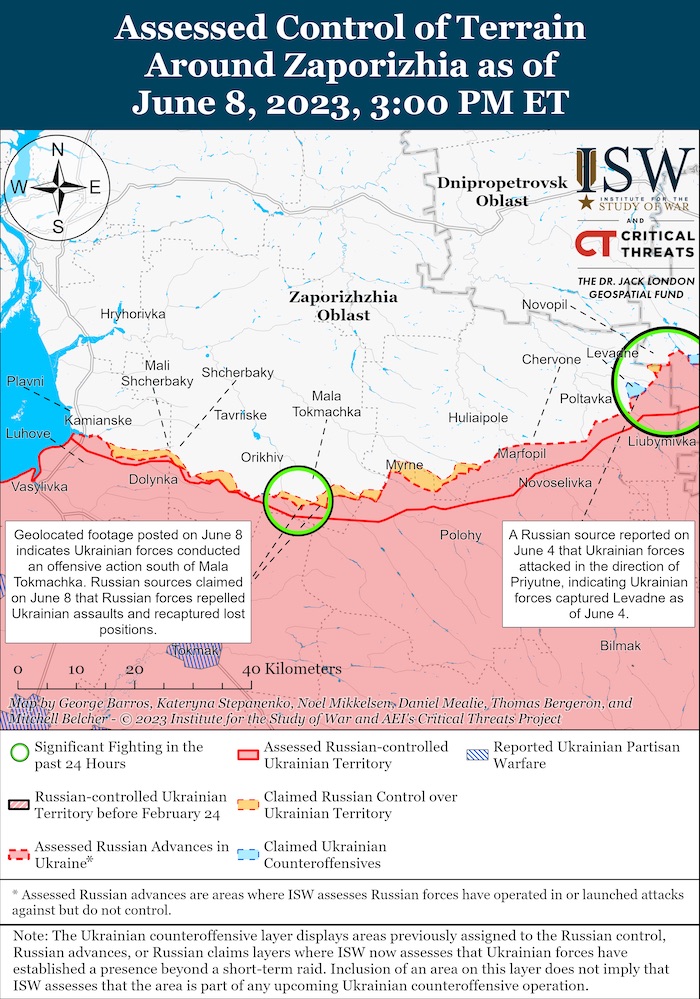
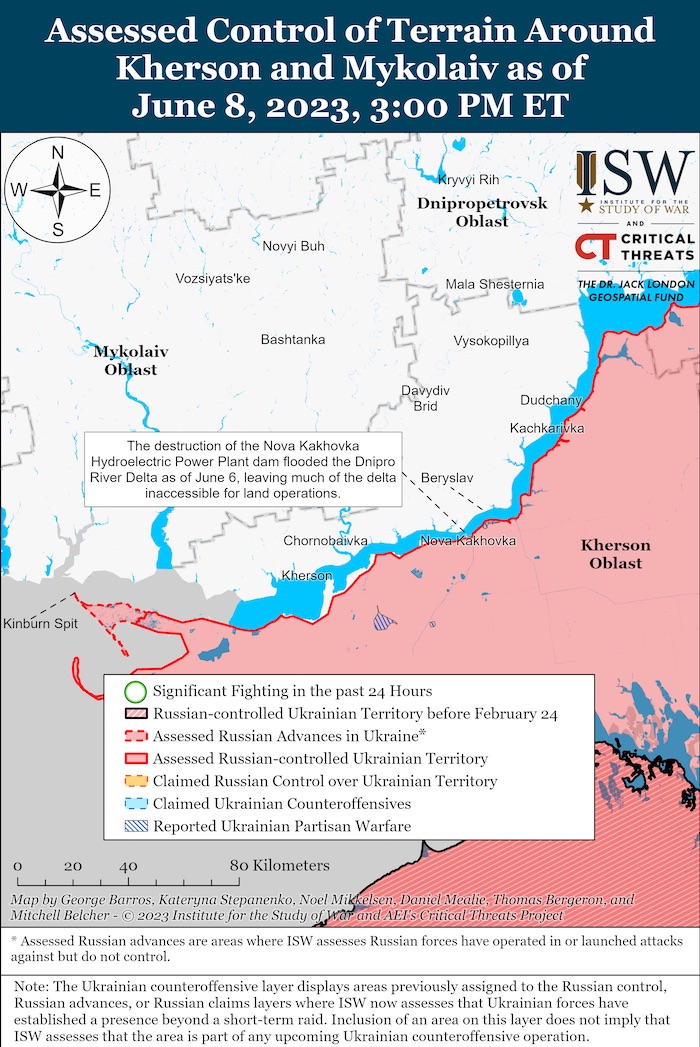
Military Updates
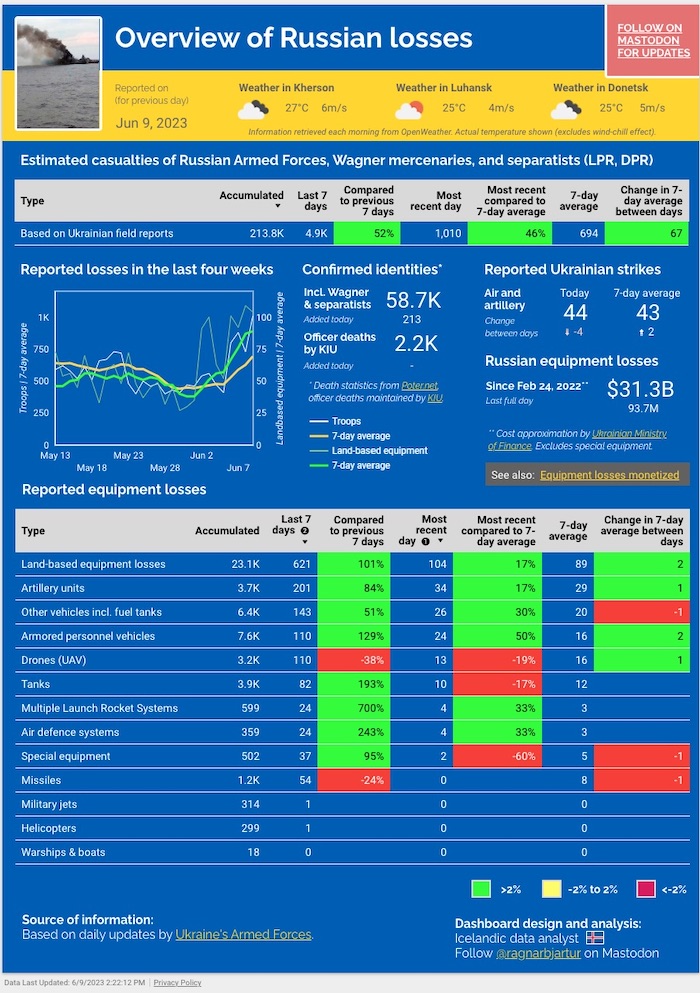
Russian troops shelled nine Ukrainian oblasts over last 24 hours. Ukrainian regional military administrations have said the Russian troops targeted nine regions of Ukraine, including Chernihiv, Sumy, Zaporizhzhia, Kharkiv, Luhansk, Donetsk, Kherson, Mykolaiv, and Dnipropetrovsk oblasts over the last 24 hours, UkrInform reported. More than 148 explosions were heard in 21 settlements of Zaporizhzhia Oblast. Russian shelling injured a 68-year-old man and damaged 32 civilian infrastructure objects.
According to British Defence Intelligence, (last 48 hours):

- The Black Sea Grain Initiative (BSGI) was extended by 60 days on 17 May 2023. However, Russia almost certainly continues to hinder grain exports by deliberately slowing inspections and actively blocking some vessels. Currently, only one or two ships are being inspected per day, compared with six to eight in Autumn 2022.
- Russia is likely attempting to force concessions on the re-opening of the Togliatti-Odesa pipeline, which exports ammonia from Russia through Ukraine, via Odesa. To complicate the situation, in recent days, the pipeline was damaged and is not currently operational.
- There is likely to be further Russian rhetoric and obstruction of the BSGI in the weeks prior to the next extension deadline of 16 July 2023.
Losses of the Russian army
Humanitarian
Zelenskyy calls on Red Cross to help rescue people from flooded towns. During his daily televised address to Ukrainian citizens, Ukraine’s President Volodymyr Zelenskyy urged international organizations such as the International Committee of the Red Cross to immediately join the rescue of people from flooded towns and villages, particularly in the temporarily occupied territory, where Ukrainian military and rescuers cannot currently reach.
Eight Ukrainian civilians injured in Russian missile attack. On 8 June, Russia launched another attack on Ukraine with Kalibr cruise missiles. According to Head of Regional Military Administration Ihor Taburets, eight civilians were injured in the strike in the Uman district of Cherkasy Oblast. Earlier, on 28 April, a Russian missile destroyed a residential high rise in Uman, killing 23 civilians, including 5 children.
Environmental
Kakhovka Dam was built to withstand nuclear strike, couldn’t be destroyed from outside – Ukrhydroproject engineering company: An outside strike could not have destroyed the Kakhovka Hydroelectric Power Plant, and Russia lies claiming that Ukraine has destroyed it, Ukrhydroproject says. The Ukrhydroproject is Ukraine’s largest engineering company in the fields of hydropower and water management construction.
Destruction of Kakhovka Dam continues, reservoir water levels keep declining – Ukrhydroenergo. Ukrainian hydropower plant operator Ukrhydroenergo reports that the water level in the Kakhovka reservoir continues to decline, while the spillway dam and the earthen insert between the station building and the sluice gate are still being destroyed.
Legal
Russia controlled Kakhovka Dam and bears responsibility for its destruction – White House. At a press briefing on 7 June, White House Press Secretary Karine Jean-Pierre noted that Russia controlled Kakhovka Dam and is responsible for its destruction “caused by this war.” Asked whether the White House Administration has had any “better insight on who or what caused the collapse of the dam,” she replied: “We are still assessing what happened, we are indeed in touch with the Ukrainians, it is the damage, obviously, and the devastation that we’re seeing is heartbreaking. We will do everything that we can to help the people of Ukraine, certainly. But I’ll say this and you’ve heard us say this before just yesterday: Russia has no business to be there in the first place. This dam was under Russia’s control, and they bear responsibility for the destruction caused by this war,” Karine Jean-Pierre said.
Support
UK to provide additional USD 900,00 funding to IAEA to support its nuclear safety work in Ukraine. The UK has announced additional funding worth over $900,000 to the International Atomic Energy Agency (IAEA) to support its missions in Ukraine. “Russia’s barbaric attacks on Ukraine’s civil infrastructure and its illegal control of the Zaporizhzhia Nuclear Power Plant runs contrary to all international nuclear safety and security norms. It claims to uphold nuclear safety standards, but its actions say otherwise,” UK Permanent Representative to the IAEA Corinne Kitsell said during the latest meeting of the agency.
Britain announces new sanctions against Belarus for aiding Russian aggression. On 8 June, Britain announced a new sanctions package against Belarus for its role in facilitating Russia’s invasion of Ukraine, including import bans and new measures aimed at preventing internet propaganda, The Guardian reports.
New Developments
Airport in Ukraine’s Lviv may resume its work, Ukrainian official says. Danylo Halytskyi Lviv International Airport may resume its operations as part of a humanitarian corridor, the head of Lviv Oblast State Administration Maksym Kozytskyi announced, according to Ukrinform. Maksym Kozytskyi said that the international airport in Lviv (western Ukraine) might become the first Ukrainian airport to resume its work since the beginning of the full-scale Russian invasion of Ukraine. Kozytskyi revealed that such an opportunity was being discussed after the EU program “Connecting Europe” signing by Ukraine’s Deputy Prime Minister Oleksandr Kubrakov and EU Commissioner for Transport Adina Vălean, Ukrinform reported.
Assessment
- On the war.
The Institute for the Study of War has made the following assessment as of June 8, 2022:
Ukraine has conducted counteroffensive operations with differential outcomes in at least three sectors of the front as part of wider counteroffensive efforts that have been unfolding since Sunday, June 4. Ukrainian officials signaled that Ukrainian forces have transitioned from defensive to offensive operations in the Bakhmut sector and are making gains of between 200 meters and nearly two kilometers on the flanks of the city.[1] Ukrainian forces have made tactical gains during limited localized counterattacks in western Donetsk Oblast near the Donetsk-Zaporizhzhia Oblast border since June 4.[2] Ukrainian forces additionally conducted an attack in western Zaporizhzhia Oblast on the night of June 7 to 8 but do not appear to have made gains as part of this attack as of the time of this publication.
Ukrainian forces conducted a limited but still significant attack in western Zaporizhzhia Oblast on the night of June 7 to 8. Russian forces apparently defended against this attack in a doctrinally sound manner and had reportedly regained their initial positions as of June 8. Russian sources began reporting late at night on June 7 that elements of Ukrainian brigades that have recently been equipped with Western kit launched an attack southwest of Orikhiv in western Zaporizhzhia Oblast.[3] Several Russian milbloggers claimed that Ukrainian forces attacked along the Mala Tokmachka-Polohy line with the aim of breaking through the Russian defensive line between Robotyne and Verbove (both about 15km southeast of Orikhiv).[4] Russian sources acknowledged that Ukrainian forces broke through the first line of defense in this area, held by elements of the 291st and 70th Motorized Rifle Regiments (42nd Motorized Rifle Division, 58th Combined Arms Army, Southern Military District) and the 22nd and 45th Separate Guards Special Purpose (GRU) Brigades, but reported that these Russian elements succeeded in counterattacking and eventually pushing Ukrainian forces back to their original positions.[5] Available geolocated combat footage suggests that limited Ukrainian forces crossed the N08 Polohy-Voskresenka highway, but Russian sourcing indicates that Russian forces likely pushed Ukrainians back in the Orikhiv direction towards the frontline and regained the lost positions.[6]
Ukrainian forces also reportedly lost Western-provided vehicles on June 8.[7] Losses are inevitable during any military undertaking. Ukrainian forces will suffer losses, including of both Western and Soviet equipment, during any offensive operations. Western equipment is not impervious to damage any more than the equipment that the Ukrainians have been using and losing since February 2022. The loss of equipment — including Western equipment — early on in the counteroffensive is not an indicator of the future progress of Ukraine’s counteroffensive. It is important not to exaggerate the impact of initial losses of Western or any other equipment, particularly in penetration battles against prepared defensive positions.
The Russian Ministry of Defense (MoD) responded to the Ukrainian attack with an uncharacteristic degree of coherency and praised Southern Military District elements for repelling the attack and regaining lost positions. The Russian MoD published a video statement by the commander of the Russian grouping in the Zaporizhzhia direction, Colonel General Alexander Romanchuk, wherein Romanchuk reported that Ukrainian forces started attacking around 0200 local time June 8 and that Russian forces, particularly those of the 42nd Motorized Rifle Division, succeeded in repelling the attack.[8] Romanchuk claimed that Ukrainian forces telegraphed the ground attack with extensive artillery preparation of the battlefield.[9] The Russian MoD also released a statement by 58th Combined Arms Army Commander Major General Ivan Popov, who credited elements of the 58th Combined Arms Army with effectively laying mines to impede Ukrainian advances.[10] The overall Russian response to the attack, both among various milbloggers and the Russian MoD, was notably coherent and relatively consistent with the available visual evidence, which may suggest that Russian forces were not surprised and reacted in a controlled and militarily sound manner. As ISW has previously assessed, the Russian information space reacts with a high degree of chaos and incoherence when taken by surprise by battlefield developments that do not allow the propaganda apparatus to develop a clear line.[11] By contrast, the Russian responses to this attack suggest that Russian forces defended in the way that they had prepared to, thus giving Russian sources a rhetorical line to coalesce around.
Russian sources provided explanations for claimed Russian successes during the June 8 attacks, praising Russian forces’ effective use of electronic warfare (EW) systems, air support, and landmines against Ukrainian forces. Multiple Russian sources reported that Russian EW severely interfered with Ukrainian command and control signals, GPS-enabled devices, UAV controls.[12] Russian sources reported that Ukrainian forces had insufficient air defense in the Orikhiv sector, that Russian forces operated with an “unprecedented” amount of rotary wing air support, and that Russian aviation was able to return to a high level of activity after not actively engaging in combat operations since the beginning of the full-scale invasion in 2022.[13] Continuous Russian missile and drone attacks against Kyiv and critical Ukrainian infrastructure may have fixed Ukraine’s more advanced air defense systems away from the frontline, although ISW cannot assess which systems would be effective against the kinds of air support missions Russian aircraft were flying. ISW’s previous assessments that Russian air and missile attacks were not setting conditions to defend against the Ukrainian counter-offensive may thus have been inaccurate. Russian sources also praised at length their claimed defensive success using layered field fortifications and landmines, with Major General Popov stating that Russian minefields played a “very important role” in defeating the initial Ukrainian advance in the early hours of June 8.[14] CNN additionally reported that an anonymous US official said that Russian landmines degraded Ukrainian armored vehicles.[15]
Russian forces appear to have executed their formal tactical defensive doctrine in response to the Ukrainian attacks southwest of Orikhiv. Russian doctrine for a defending motorized rifle battalion calls for a first echelon of troops to repel or slow attacking forces with minefields, fortifications, and strongpoints, with a second echelon of forces counterattacking against an enemy breakthrough.[16] Russian forces apparently operated in this fashion in this sector – Ukrainian forces penetrated the initial defensive lines; Russian forces pulled back to a second line of fortifications; and Russian reserves subsequently counterattacked to retake the initial line of defenses.[17] This maneuver is a regular feature of defensive operations and has been executed by both Ukrainian and Russian forces throughout the war. Early control of terrain changes day to day should thus not be misconstrued as the overall result of a wider attack.
Ukrainian attacks in western Zaporizhzhia on June 8 do not represent the full extent of Ukrainian capabilities in the current counteroffensive. Ukraine previously demonstrated the ability to conduct a coordinated and effective offensive operation using multiple mechanized brigades as early as September 2022 during the liberation of Kharkiv Oblast. Ukrainian forces possessed this capability – in terms of both available forces and the capacity to coordinate complex attacks – before the provision of Western kit for offensive brigades and additional training from NATO partners. Ukraine’s counteroffensive will likely consist of many undertakings of varied size, including more localized attacks as observed in this sector on June 8, and the smaller efforts do not represent the maximum capacity of Ukrainian numbers or effectiveness. Ukraine reportedly formed 12 dedicated counteroffensive brigades, nine equipped with Western kit and three with existing equipment, and these units will almost certainly be joined by experienced Ukrainian units already online.[18] Ukraine appears to have committed only a portion of the large reserve of forces available for counteroffensive operations, and observers should avoid counting down reported Ukrainian brigades committed or reportedly damaged Western kit as the measure of the remaining effective combat power of Ukrainian forces.
It is additionally noteworthy that the Russian Southern Military District Forces deployed in this particular area are likely to be a higher quality force grouping than Russia has elsewhere in theater, and their defensive performance is unlikely to be reflective of defensive capabilities of Russian groupings elsewhere on the front. Elements of the 58th Combined Arms Army have been deployed in a doctrinally consistent manner to the Orikhiv area and have been conducting defensive preparations in this sector of the front for several months.[19] The 291st and 70th Motorized Rifle Regiments in particular have reportedly gained experience in defending against limited Ukrainian reconnaissance-in-force efforts this area over the past months and have had time to commit to and prepare for defensive operations and familiarize themselves with the terrain.[20] The 58th Combined Arms Army elements in this sector, therefore, are likely generally fresher and more experienced than elements in other areas of the front. The Russian defense of this sector should not be taken as indicative of overall Russian defensive capabilities as Ukraine continues counteroffensive operations. Russian forces defending in other sectors have indeed performed much more poorly. Ukraine, having recently regained the battlefield initiative across the theater, will be able to choose exactly where in to continue attacking based on observed defensive capabilities of various Russian groupings along the frontline among other factors.
Russian forces and occupation authorities continue to exacerbate the humanitarian ramifications of the flooding resulting from the Kakhovka Hydroelectric Power Plant (KHPP) dam break. The Ukrainian General Staff reported on June 8 that Russian forces are hiding amongst civilians who are evacuating from flooded settlements on the east (left) bank of the Dnipro River and that occupation authorities are housing evacuated residents in boarding houses and recreation centers where Russian troops and equipment are located.[21] Several Ukrainian and Western sources additionally reported that Russian troops shelled a flooded evacuation site in Kherson City, killing one civilian and injuring nine.[22] Russian occupation authorities claimed that Ukrainian forces shelled evacuation efforts on the east bank but did not provide visual evidence commensurate with these allegations.[23]
Russian President Vladimir Putin has reportedly postponed his annual press conference from June 2023 until November or December 2023.[24] Russian news outlet Kommersant claimed on June 8, citing sources within the Kremlin, that Putin is postponing his annual “Direct Line” live journalistic forum until the Russian military situation is more stable, which the sources characterized as likely in November or December. Kommersant’s source reportedly stated that these dates are preliminary, and that Putin aims to hold the “Direct Line” before the March 2024 presidential elections.[25] ISW has previously assessed that Putin would likely hold the “Direct Line” in early June 2023 after Russian forces captured Bakhmut, and pushing back the forum indicates that the Kremlin may perceive the capture Bakhmut as an insufficient informational victory to compensate for the overall unstable Russian military situation in Ukraine.[26] Delaying the “Direct Line” forum further illustrates Putin’s decline from a seemingly involved and strong leader to one more often portrayed as minutely involved in small infrastructure projects, as ISW has previously noted.[27]
Key Takeaways
- Ukraine has conducted counteroffensive operations with differential outcomes in at least three sectors of the front as part of wider counteroffensive efforts that have been unfolding since Sunday, June 4.
- Ukrainian forces conducted a limited but still significant attack in western Zaporizhzhia Oblast on the night of June 7 to 8. Russian forces apparently defended against this attack in a doctrinally sound manner and had reportedly regained their initial positions as of June 8.
- The Russian Ministry of Defense (MoD) responded to the Ukrainian attack with an uncharacteristic degree of coherency and praised Southern Military District elements for repelling the attack and regaining lost positions.
- Russian sources provided explanations for claimed Russian successes during the June 8 attacks, praising Russian forces’ effective use of electronic warfare (EW) systems, air support, and landmines against Ukrainian forces.
- Russian forces appear to have executed their formal tactical defensive doctrine in response to the Ukrainian attacks southwest of Orikhiv.
- Ukrainian attacks in western Zaporizhzhia on June 8 do not represent the full extent of Ukrainian capabilities in the current counteroffensive.
- It is additionally noteworthy that the Russian Southern Military District Forces deployed in this particular area are likely to be a higher quality force grouping than Russia has elsewhere in theater, and their defensive performance is unlikely to be reflective of defensive capabilities of Russian groupings elsewhere on the front.
- Russian forces and occupation authorities continue to exacerbate the humanitarian ramifications of the flooding resulting from the Kakhovka Hydroelectric Power Plant (KHPP) dam break.
- Russian President Vladimir Putin has reportedly postponed his annual press conference from June 2023 until November or December 2023.
- Russian forces continued to conduct limited ground attacks on the Kupiansk-Svatove line and around Kreminna.
- Ukrainian forces made limited gains around Bakhmut, and Russian forces conducted limited ground attacks along the Avdiivka-Donetsk City line.
- Ukrainian forces continued to conduct limited ground attacks on the administrative border between Donetsk and Zaporizhzhia oblasts.
- The Russian MoD continues to posture itself as a firm authority over the defense industrial base (DIB) through emphasizing its ability to transport new equipment to the front.
- Russian occupation authorities are reportedly resorting to punitive measures against civilian populations in occupied Ukraine due to Russian occupation authorities’ decreasing influence over civilians.





